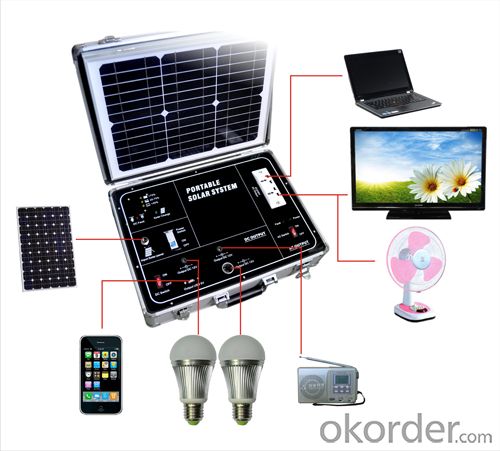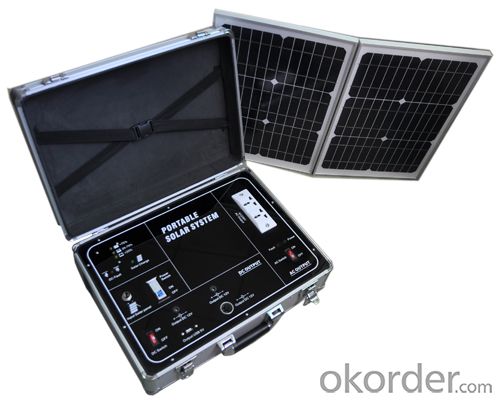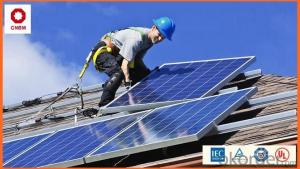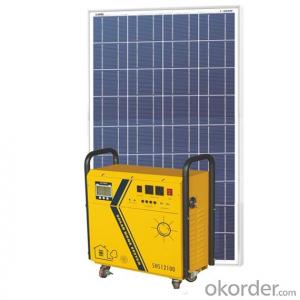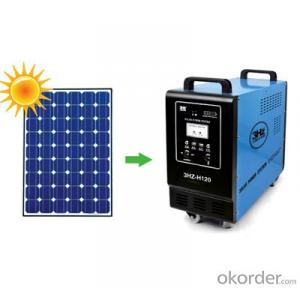Solec Solar Energy Systems Portable Solar Power System 500W Modified Sine Wave with 34W Solar Panels
- Loading Port:
- Shekou
- Payment Terms:
- TT OR LC
- Min Order Qty:
- 10 unit
- Supply Capability:
- 5000 unit/month
OKorder Service Pledge
OKorder Financial Service
You Might Also Like
Functions
1.The solar power system designed to provide DC power and AC power ,supply for lighting, mobile phone charging, run the
DC Fan and Radio, and TV ,computer etc.
2.Built-in PWM charge controller, real time display of battery capacity and load status.
3.Built-in maintenance-free Lead-acid battery.
4.With several output socket, can output voltage DC12V and USB DC5V at the same time.
5. Built-in DC to AC power inverter, can output AC220V/50HZ ,
6.Voice warning and together LED indicator shows the battery get low.
Technical parameters
| System voltage | 12V |
| Battery capacity | 20AH/12V |
| Max.charge current | 10A |
| Build-in solar panel Power | 38W, open circuit voltage:17.5V |
| Output voltage | DC output : DC socket: 12V/5A USB output: DC5V/800mA Cigar lighter: DC12V/10A Output AC : AC220V/50HZ |
| load power | DC Power: <120W (total power), AC Power:<500W |
| LVD (Low-voltage dis-cononect) | DC load LVD: 11.0V, AC load LVD: 10.0V |
| DC load re-connect voltage | 12.5V |
| HVD (High-voltage dis-connect) | 15.5V |
| Weight | 15KG |
| Dimension | 46*34*16 cm |
- Q: Are there any risks of electrical grounding issues with solar energy systems?
- Yes, there are some risks of electrical grounding issues with solar energy systems. One of the main risks is the potential for electric shock. If the grounding system in a solar energy system is not properly installed or maintained, it can lead to a build-up of electrical current in the system. This can result in a person coming into contact with a live electrical component and experiencing an electric shock. Another risk is the potential for fire. If the grounding system is not properly installed, it can cause electrical arcing, which can lead to a fire. This is particularly dangerous in solar energy systems as they are typically installed on rooftops, where a fire can quickly spread to the rest of the building. Additionally, a faulty grounding system can also lead to damage to the solar energy system itself. Without proper grounding, electrical surges and fluctuations can occur, which can damage sensitive components of the system, such as inverters or batteries. To mitigate these risks, it is crucial to ensure that the grounding system of a solar energy system is properly installed and regularly inspected and maintained. This includes using proper grounding equipment, such as grounding rods or conductors, and ensuring that all connections are secure and free from corrosion. Regular testing of the grounding system should also be conducted to ensure its effectiveness. It is recommended to hire a qualified professional to install and maintain the grounding system to minimize the risks associated with electrical grounding issues in solar energy systems.
- Q: How does a PV system convert sunlight into electricity?
- A PV system converts sunlight into electricity through the use of photovoltaic cells. These cells are made up of semiconductor materials, usually silicon, which have the ability to absorb photons from sunlight. When the sunlight hits the cells, the photons transfer their energy to the electrons in the semiconductor material, causing them to become excited and break free from their atoms. This creates a flow of electrons, which is then captured as direct current (DC) electricity by the PV system. The DC electricity is then converted into alternating current (AC) electricity through an inverter, making it suitable for powering homes and other electrical devices.
- Q: Can solar energy systems be used for powering agricultural irrigation systems?
- Yes, solar energy systems can be used effectively to power agricultural irrigation systems. Solar-powered water pumps are commonly used in agricultural settings to pump water from wells, rivers, or other sources for irrigation purposes. This renewable energy source helps farmers reduce their reliance on fossil fuels and lower their operational costs while ensuring a sustainable and reliable source of power for irrigation.
- Q: Do solar energy systems require batteries for energy storage?
- Batteries are not always required for energy storage in solar energy systems. While they can store extra energy generated by solar panels for later use, they are not essential. In grid-connected solar systems, excess energy can be sent back to the utility grid, allowing homeowners to draw power from the grid when their panels are not producing enough. This eliminates the need for batteries as the grid acts as a virtual storage system. However, for off-grid systems or areas with unreliable grid access, batteries are commonly used to store excess energy. Ultimately, whether or not batteries are used in a solar energy system depends on the specific circumstances and requirements of the installation.
- Q: Can solar energy systems be used in areas with limited roof access for maintenance?
- Yes, solar energy systems can be used in areas with limited roof access for maintenance. While it is more common to install solar panels on rooftops for optimal sun exposure, there are alternative options available. Ground-mounted solar panels can be installed in areas where roof access is limited, allowing for easier maintenance and cleaning. Additionally, solar panel systems can also be integrated into other structures such as carports or pergolas, providing an alternative to traditional rooftop installations. These alternatives ensure that solar energy systems can be utilized effectively in areas with limited roof access for maintenance.
- Q: How much maintenance is required for a solar energy system?
- Solar energy systems typically require minimal maintenance. Regular cleaning of the solar panels to remove dust and debris is recommended to ensure optimal performance. Additionally, checking the system's components, such as inverters and wiring, at least once a year is advisable. Overall, solar energy systems are designed to be durable and reliable, requiring little ongoing maintenance.
- Q: Can solar energy systems be used in urban environments?
- Yes, solar energy systems can definitely be used in urban environments. In fact, urban areas can be ideal for solar energy due to the high population density and availability of rooftop spaces. Solar panels can be installed on buildings, homes, and other structures in cities to harness the power of the sun and provide clean and renewable energy. Additionally, advancements in solar technology have made it possible to integrate solar panels into various urban infrastructure, such as streetlights and bus stops, further expanding the use of solar energy in urban environments.
- Q: Can solar energy systems be installed on sports stadiums?
- Yes, solar energy systems can be installed on sports stadiums. In fact, many stadiums worldwide have already adopted solar technology to harness clean and renewable energy. These systems can be mounted on stadium rooftops, parking lots, or even integrated into the design of the stadium itself. The use of solar energy in sports stadiums not only reduces their carbon footprint but also provides a sustainable and cost-effective solution for meeting their energy needs.
- Q: Can solar energy systems be used in camping or outdoor activities?
- Yes, solar energy systems can definitely be used in camping or outdoor activities. In fact, solar power is a great solution for off-grid living or when you're away from traditional power sources. Portable solar panels, also known as solar chargers, can be used to harness the sun's energy and convert it into electricity to power various camping or outdoor devices. There are several advantages of using solar energy systems for camping. Firstly, they provide a renewable and sustainable source of power, reducing your reliance on fossil fuels or disposable batteries. This not only helps to protect the environment but also saves you money in the long run. Solar energy systems can be used to charge a wide range of devices, such as smartphones, tablets, laptops, cameras, portable speakers, and even small appliances like coolers or lights. This ensures that you can stay connected, capture memories, or simply enhance your camping experience without worrying about battery life. Portable solar panels are lightweight, compact, and easy to carry, making them ideal for camping or outdoor activities. They can be set up in various ways, including attaching them to a backpack, placing them on the ground, or mounting them on a tent or RV. Some solar chargers also come with integrated batteries, allowing you to store energy for later use, ensuring a constant power supply even during cloudy days or at night. It is worth mentioning that the efficiency and power output of solar energy systems can vary depending on factors like weather conditions, panel quality, and the angle at which they are positioned towards the sun. Therefore, it's important to choose reliable and reputable solar products that suit your specific needs. Overall, solar energy systems are a fantastic option for camping or outdoor activities, providing a clean, reliable, and sustainable source of power. Whether you want to charge your devices, light up your campsite, or power small appliances, solar power can greatly enhance your outdoor experience.
- Q: Can solar energy systems be used for powering remote sensing devices?
- Yes, solar energy systems can be used to power remote sensing devices. Solar panels can convert sunlight into electricity, which can then be used to power various types of remote sensing devices such as weather stations, environmental monitoring systems, and satellite communication equipment. This allows for the collection and transmission of data in remote areas where access to traditional power sources may be limited or unavailable.
Send your message to us
Solec Solar Energy Systems Portable Solar Power System 500W Modified Sine Wave with 34W Solar Panels
- Loading Port:
- Shekou
- Payment Terms:
- TT OR LC
- Min Order Qty:
- 10 unit
- Supply Capability:
- 5000 unit/month
OKorder Service Pledge
OKorder Financial Service
Similar products
Hot products
Hot Searches
Related keywords




